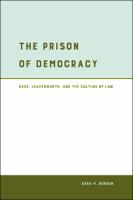The Prison of Democracy
Race, Leavenworth, and the Culture of Law
Abstract
The Prison of Democracy uses a prison designed as a replica of the U.S. capitol building as a prism for understanding the relationship between prisons and democracy. As a historical and archival study of the federal prison system, this book examines the history of the racial carceral state and suggests that mass incarceration is more than a moment in time—it is a theory of the state that assigns civil death to the body. In a state that has always been carceral, the logic of mass incarceration has emerged over time as part of the foundation of “democratic” governance. Because of the idea that the carceral state was weak in the years before the development of the Bureau of Prisons in 1929, this book examines the early history of the federal prison system. It begins in the gothic institutions of the states, where federal prisoners were housed for nearly a century and where civil death was signified in the text of the building. It also locates the idea of Leavenworth at the intersections of Indian Territory and Bleeding Kansas, two regional formations rooted in settler colonialism and slavery that were part of the federal carceral apparatus that preceded Leavenworth. The book also finds the idea of Leavenworth in the racialization of the penitentiary in the border states, and in the mass incarceration of political prisoners in the twentieth century. The book explores Leavenworth’s institutional life in order to imagine new terrains of justice in the prison’s afterlife.
Keywords
mass incarceration; carceral democracy; carceral state; Leavenworth; federal prisonsDOI
10.1525/luminos.66ISBN
9780520296961OCN
1135853540Publisher
University of California PressPublisher website
https://www.ucpress.edu/Publication date and place
Oakland, 2019Classification
History
Crime and criminology
Political science and theory


 Download
Download